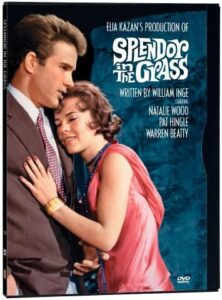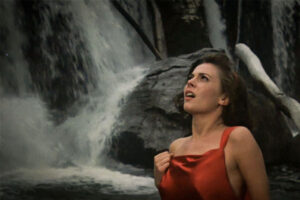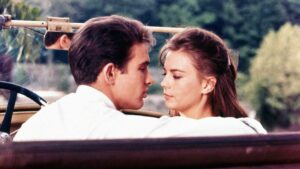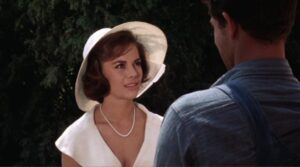“Splendor in the Grass” – an Age of Innocence

Title: “Splendor in the Grass”
Release Date: 1961
Director: Elia Kazan
Cast: Natalie Wood, Warren Beatty, Barbara Loden, Zohra Lampert, Sandy Dennis
This is one of Elia Kazan’s most outstanding films. Brave, moving to the core, it stays in the memory and the heart for a long time. “Splendor in the Grass” is an initiation movie – about the charm of youthful love and the havoc it wreaks on individual lives when youthful ideals are abandoned.
“Splendor in the Grass” – a story of destroyed love
“Splendor in the Grass” was not coincidentally awarded the Oscar for Best Screenplay. It was created by William Inge, one of the most outstanding American writers. The value of the movie was complemented by wonderful actors: Natalie Wood and Warren Beatty, who debuted here, playing two teenagers on the verge of adulthood in Kansas, in 1928. Dean and Bud love each other to the point of madness and can’t live without each other. But it is the late 1920s, in the conservative South of the United States, where girls are stigmatized for being too passionate and boys are forced to be guided by reason and an awareness of their hopes.
Dean, constantly reprimanded by a puritanical mother guarding her virtue, is afraid to allow intimate moments. In turn, the increasingly frustrated Bud is unable to complete his amorous plans and marry his beloved. The father, frightened by the prospect of his son marrying an indigent girl, convinces the boy that he must first finish his studies at Yale, and then he can only think about starting a family. An extremely sensitive girl has a nervous breakdown in literature class while reading William Wordsworth’s moving poem about the fleetingness of lush spring grasses and the fragility of flowers. Desperate for help, Dean tries to give herself to Bud, but he rejects her advances, leading her to attempt suicide. Dean spends the next three years in a mental institution and Bud, sent to college, finds comfort in the arms of an Italian waitress.

Meanwhile, the great stock market crash of the 1930s arrives and both Dean and Bud’s parents lose everything. It turns out that using common sense was of no use. Cured, Dean leaves the hospital where a young doctor (one of the patients) proposes to her, and to see if she can start a new life, she decides to visit Bud. The girl arrives at the farm where her former beloved lives with his wife and son, expecting another offspring. After a short conversation, Dean leaves.
“Splendor in the Grass” – the romantic cult of youth
“Splendor in the Grass” is a film in which Elia Kazan unequivocally takes the side of youth and its glorious dreams. The old sanctioned truths of experience, represented by the parents of the lovers, crumble when confronted with the power of beautiful romantic love. No one can predict fate, even the greatest fortune can fail, so it is not worth putting the arguments of economics and reason above the rationale of the heart. Only love is a timeless value, for which it always pays to fight to the end.
Moreover, children must go their own way, Kazan says, disregarding their parents’ ambitions – for youth comes along only once. Only once does one experience the springtime of life, and one has the right, even the duty, to use this time to experience the power of dreams and to follow their voice.

“Splendor in the Grass” discredits not only the world based on the power of money, but also the traditional morality that equates sex with sin. In this respect, Kazan’s film was one of the most daring works of its time. The director did not hesitate to show what erotic frustration can lead to. The film opens with a symbolic shot of a beautiful, roaring waterfall, over which Dean and Bud make passionate love in their car. The waterfall refers to the unbridled power of desire and indicates its purity (crystalline water) and life-givingness (water gives life). The same waterfall, however, becomes the setting of Dean’s suicide attempt – here again we are dealing with meaningful symbolism – emphasizing the destructive effects of the suppression of urges.
“Splendor in the Grass” – weak Bud and vulnerable Dean
The film “Splendor in the Grass” is also extremely interesting portrayals of the lovers. In a sense, they are drawn in contrast. Ostensibly, it is Dean, who breaks down, tries to kill herself and ends up in a mental hospital, who seems to be the weaker personality. In reality, however, she is the one who shows impressive strength in fighting for her affection. Despite her mother’s orders, she decides to break the rules and make love to Bud – but he then rejects her. Incidentally, Natalie Wood’s role may be considered the best in her entire career. On the other hand, Bud, who seems to act rationally, is actually weak – he yields to his father’s pressure and gives up on love. What is more, he does not wait for his beloved and quickly bonds with another woman.

The contrast between the protagonists is brought out above all in the finale of Kazan’s work. Dean looks phenomenal here – he is wearing a white flowing dress, white gloves and a hat of the same color. It is in this guise – as a beautiful and graceful lady – that she stands before Bud, who is covered with a mess of field work, and his wife in a stained apron. One gets the impression that Dean somehow shines against the background of ordinary, dusty scenery. He doesn’t fit in; he is an individualist who, though at great cost, has nevertheless managed to break free from the hypocritical morality of the stuffy South. Bud, in turn, has been broken and “soaked up” by a world of rigid precepts. White also symbolizes the girl’s moral purity – she has never given up in the fight for love, unlike her overly fickle lover. For this reason, it is Dean who can repeat the poem-poem in the last scene with peace of mind. He can trust that:
“Though nothing can bring back the hour
Of splendour in the grass,
of glory in the flower,
We will grieve not, rather find
Strength in what remains behind”
Literature:
A.Garbicz, “Kino. Wehikuł magiczny. Przewodnik osiągnięć filmu fabularnego. Podróż trzecia. 1960 – 1966”.
